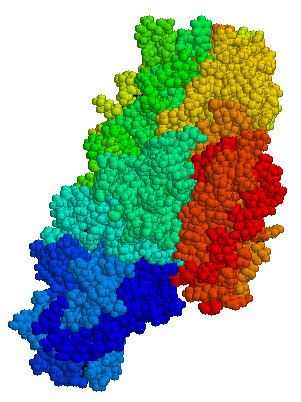 | ||
Gliadin is a class of proteins present in wheat and several other cereals within the grass genus Triticum. Gliadins, which are a component of gluten, are essential for giving bread the ability to rise properly during baking. Gliadins and glutenins are the two main components of the gluten fraction of the wheat seed. This gluten is found in products such as wheat flour. Gluten is split about evenly between the gliadins and glutenins, although there are variations found in different sources.
Contents
Gliadin is the water-soluble component of gluten, while glutenin is insoluble. There are three main types of gliadin (α, γ, and ω), to which the body is intolerant in coeliac (or celiac) disease. Diagnosis of this disease has recently been improving.
Gliadin can cross the intestinal epithelium. Breast milk of healthy human mothers who eat gluten-containing foods presents high levels of non-degraded gliadin.
Types
The α, γ, and ω gliadin types are separated and distinguished based on their amino acid sequences.
Biochemistry
Gliadins are prolamins and are separated on the basis of electrophoretic mobility and isoelectric focusing.
Metabolism
Gliadins are known for their role, along with glutenin, in the formation of gluten. They are slightly soluble in ethanol and contain only intramolecular disulfide links. They also cause some of the best examples of food-derived pathogenesis. People with gluten-sensitive enteropathy (the severe form of which is celiac disease) are sensitive to α, β, and γ gliadins. Those with WD urticaria and Baker's asthma are sensitive to ω-gliadins.
Gliadin can also serve as a useful delivery method for sensitive enzymes (such as superoxide dismutase, which is fused with gliadin to form glisodin) – this helps protect them from stomach acids that cause breakdown.
For useful description of the gliadins see:
Deamidated gliadin
Deamidated gliadin is produced by acid or enzymatic treatment of gluten. The enzyme tissue transglutaminase converts some of the abundant glutamines to glutamic acid. This is done because gliadins are soluble in alcohol and cannot be mixed with other foods (like milk) without changing the foods' qualities. Deamidated gliadin is soluble in water. The cellular immunity to deamidated α-/β-gliadin is much greater than α/β-gliadin and can result in symptomatic gluten-sensitive enteropathy.
Celiac disease
Celiac disease is a chronic, immune-mediated intestinal disorder, in which the body becomes intolerant to gliadin, which is a component of gluten. Individuals with celiac disease exhibit a lifelong intolerance of wheat, barley and rye – all of which contain gliadins. Gliadin proteins have the ability to provoke an autoimmune enteropathy caused by an abnormal immune response in genetically susceptible individuals. Specific amino acid sequences within the gliadin proteins are responsible for this activity.
The main problems with this disease is that it often goes unrecognized for many years, in which it can cause serious damage to several organs, and most cases currently remain unrecognized, undiagnosed and untreated. Celiac disease with “non-classic symptoms” is the most common clinical type and occurs in older children (over 2 years old), adolescents and adults. It is characterized by milder or even absent gastrointestinal symptoms and a wide spectrum of non-intestinal manifestations that can involve any organ of the body, and very frequently may be completely asymptomatic both in children (at least in 43% of the cases) and adults. Untreated celiac disease may cause malabsorption, reduced quality of life, iron deficiency, osteoporosis, an increased risk of intestinal lymphomas and greater mortality. It is associated with some autoimmune diseases, such as diabetes mellitus type 1, thyroiditis, gluten ataxia, psoriasis, vitiligo, autoimmune hepatitis, dermatitis herpetiformis, primary sclerosing cholangitis, and more.
The only available treatment for celiac disease is a strict gluten-free diet in which the diseased person does not ingest any gluten. There have been searches for an affordable and much better treatment, but the only treatment remains to abstain from ingesting any gluten.
